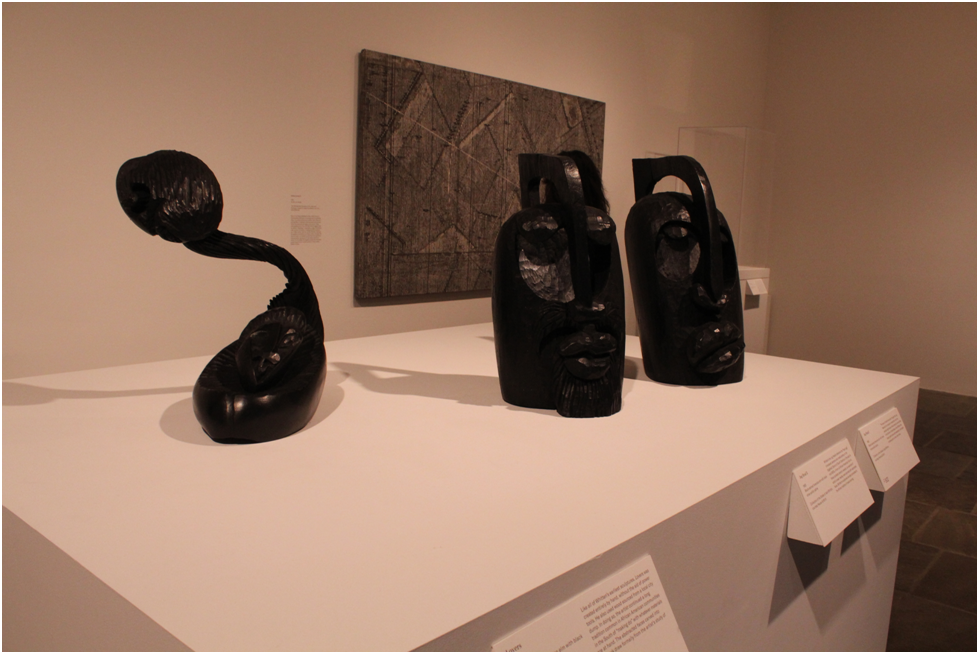The Magic is Still Potent: Whitten’s Retrospective
When I first entered this exhibit, I knew only bits and pieces of Whitten’s work - namely, his use of a “developer”, a handmade canvas-sized squeegee contraption that allowed him to make a painting in a manner of seconds. His developer paintings were on display, as were his homages, and sculpture from throughout his career.
I found the paintings and mosaics to be deeply accessible - there’s something so impressionistic, so fun, about the developer, a breath of fresh air in an art world that can feel stuffy and hyper-intellectual. I found the homages similarly accessible and sublime - abstract captures of significant black figures (and John Lennon) that reminded me of paintings of saints. Not in terms of style, of course, but in terms of the veneration, the capture of someone so significant and excellent they may as well be otherworldly (and John Lennon). I saw these paintings as existing on a similar plane as the one that allowed for real people to become standard holy figures on candles - a complete abstraction of the person into their energetic form. A kind of magic.
I wasn’t aware that so much of his work was sculpture, and so found myself pleasantly surprised. The retrospective contextualized Whitten’s sculpture through references and comparisons to African sculpture - there were African masks next to many of the sculptures, with the exhibit trying to drive home that Whitten drew heavily from the logic and aesthetics of African sculpture.
I found these contextual efforts to be a bit shallow though - the masks, rather than complimenting the pieces and contextualizing them, rubbed me as tokenizing. I say this because Whitten’s sculpture, while inspired by African art, was nonetheless heavily inspired by his surroundings, namely, being a black man in America, and his frequent travels to Greece. (Which, to be fair, the exhibit referenced frequently). To place Whitten’s sculpture next to the African masks which inspired them told a story that was too linear and descendential, and obscured the nuances for me. Why not also project video of the Greek island that inspired Whitten, and that provided so many of the materials? Or reference clips from later in Whitten’s life, when he declares he is tired of being a poor black artist?
It wasn’t until later that I found an engagement with African art that helped me make sense of the work:
“When Matisse showed me his first Negro head, he talked about Egyptian art. But when I went to the Musee de l’homie, the masks were not just sculpture. They were magical objects… I understand what their sculptures did for the Negroes…They were weapons — to keep people from being ruled by spirits, to help them free themselves. Tools” -Picasso, quoted by André Malraux, from Arthur Jafa’s My Black Death
“Ah-hah” I thought, and remembered the scene in Black Panther where the revolutionary character, Killmonger, visits a museum to steal an art piece made of a rare and magical metal. As he kills the guards and takes the piece, he is triumphant because he has stolen back an artifact stolen from his people, and is one step closer to Black liberation. No spoilers here however.
Whitten’s pieces were now obvious to me as spells of sorts - there was a sculpture on display loaned by his widow that lived in their bedroom, casting its protections. My favorite was a somewhat brutal amalgamation of nails, with a scrap of Whitten’s AmEx nailed on as a signature. His pieces were not stolen, like the masks, however. They were loaned. Potent in a way that the African masks had been robbed of precisely because they were stolen. And given how many of the magic artifacts have been stolen, robbed of their context and power, I hope Jack’s figures continue to cast their spells from within the walls of the Met Breuer.
Whitten’s Retrospective can be found at the Met Breuer through Dec 2.



